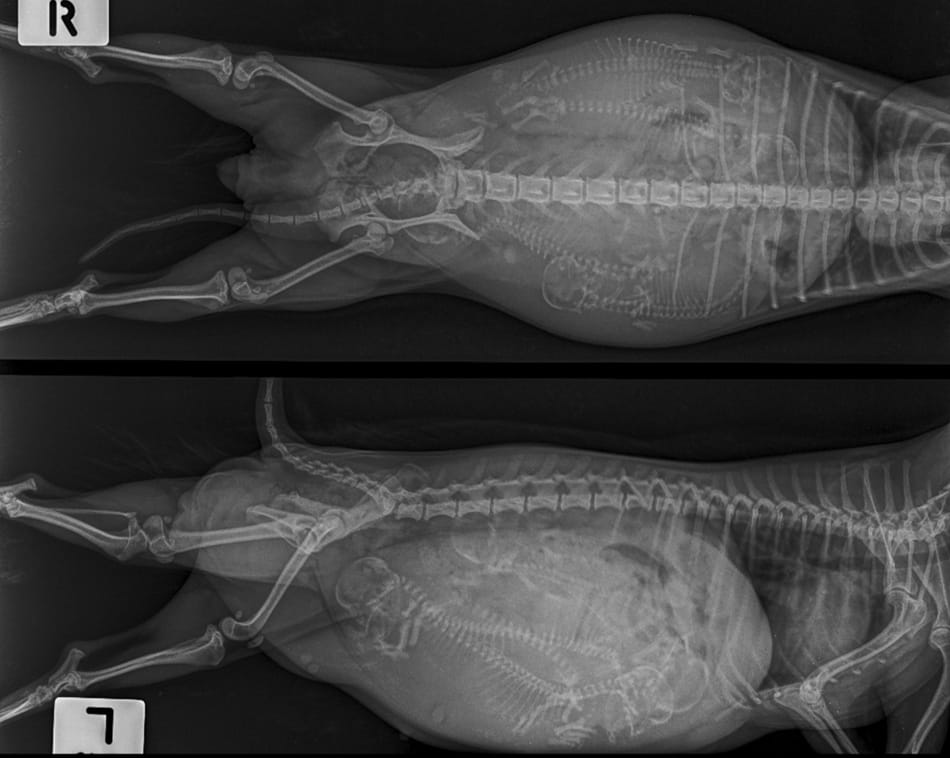
If you’ve decided to breed your Doberman, you’re probably beyond excited to confirm when she’s actually pregnant. Or maybe you think an unexpected mating may have taken place and you are looking for an explanation of the strange symptoms you’ve been seeing. Either way, this article should help you get a solid idea of if your Doberman is, in fact, pregnant.
Each expectant dog deals with their pregnancy a little differently, but in general, there are common signs in the Doberman breed that indicates that breeding was successful. These include noticeable swelling in the stomach and nipples, changes in behaviors and emotions, increased hunger, nesting behaviors, and decreased activity as the time of whelping gets nearer and nearer. Below are some of the specifics, including what you can expect week-by-week with a pregnant Doberman.
#1 – Emotional Changes
As your Doberman’s pregnancy progresses, she will have to deal with the same hormonal shifts that pregnant humans struggle with. Any sudden emotional changes can sometimes be a sign of pregnancy, but, to be more specific, keep an eye out if your dog is suddenly acting:
- Irritable: Your Doberman may act a bit more short-tempered with you or with the other dogs in your family than usual. This is pretty normal with pregnant dogs and may be an indicator that she’s getting ready to be a defensive mother.
- Clingy: On the other hand, if you notice your Dobie wants to spend more time around you or other members of your family, this could be another sign that she’s pregnant. These dogs are natural pack animals, so it’s normal for her to want to be close to her “pack” (or family) when she’s feeling more vulnerable due to pregnancy.
- Moody: Any sudden or unexpected mood swings can be a sign of pregnancy for your dog. Look out for changes in mood that seem to have no real explanation, and just make sure you help your Doberman feel comfortable as best as you can, whatever her mood.
#2 – Increased Hunger
Your Dobie will often experience increased hunger during pregnancy due to the fact that their developing puppies are putting a nutritional demand on their body. If you’re looking for ways to supplement your dog’s diet during pregnancy without hurting her health, here are some common approaches Doberman breeders will take:
- Increase her food by half. If you’re feeding your dog a cup of kibble or dry food a day, bump that serving size up to a cup and a half as recommended by your vet. If your Doberman is still acting hungry, you can try increasing her food again, but the key is to do so in controlled amounts.
- Try mixing wet and dry food. The key to feeding your pregnant Doberman is to make sure that she’s getting all of the nutrients that she needs. A blend of wet and dry dog food may help to not only provide a variety of nutrients but also hydrate your dog (important in hot climates) while still providing the dental benefits of dry food.
- Try adding raw food (or just add milk). A raw diet will get your dog plenty of vitamins and minerals that will help her through her pregnancy, but it can be slightly more expensive and should only be attempted at the close supervision of a veterinarian or canine nutritionist. A cheaper alternative is adding milk to your Doberman’s meals in order to give her an extra dose of calcium.
To learn about feeding your Doberman raw foods, take a look at my article Should You Be Feeding Your Doberman Raw Meat. Never introduce raw foods into your pregnant Doberman’s diet without speaking with a qualified veterinarian first.
#3 – Noticeable Swelling
Just like with humans, one common symptom Dobermans will show is swelling during their pregnancy. Because Dobermans, like all dogs, have a relatively short gestation period (about 9 weeks), you should be able to spot the changes fairly soon. In particular, look for swelling in:
- The Stomach: You may notice your Doberman putting on weight even if you haven’t increased her food. In particular, swelling in the lower stomach around the hips is usually a strong indicator of pregnancy.
- The Nipples: As your dog’s pregnancy progresses, she will start to produce milk. As a result, her nipples and teats (the area around the nipple) will begin to swell and distend as she prepares to nurse her puppies.
- The Vulva: Generally, your dog’s vulva will not begin to swell until the final weeks of her pregnancy, so this is more of a last-minute confirmation than an early clue. However, swelling in the vulva can serve as a sign that your Doberman is ready to whelp (give birth to) her puppies in the next few days to a week.

#4 – Nesting Behavior
Nesting behavior is common in just about every species and pregnant Dobermans are certainly no exception. As her pregnancy progresses, you may notice her starting to squirrel away blankets or pile up clutter around her bed.
Granted, Dobermans like to do this naturally anyway, but you should pay extra attention if it seems like she’s doing this more than normal. If it has increased lately, it may be a sign that your dog is getting ready to keep her puppies safe and warm. In general, nesting isn’t a problem, but make sure your Dobie is safe by keeping an eye out for:
- Sharp Objects: Make sure she isn’t pulling anything into her nest of blankets and other soft materials that could poke, cut, or scrape her. In general, your Dobie will likely naturally avoid these types of materials, but I certainly wouldn’t rely on this, so make sure to double-check.
- Choking Hazards: Shredded blankets or other cozy materials can still present a choking hazard if your Doberman likes to chew on everything within reach. Check your dog’s nest for long fiber strands or other potential threats especially if you have one of those Dobies (like many of us do) who likes to chew and swallow fibrous materials.
Don’t forget that although your dog may be instinctually building up her own nest, you’ll want to transfer the mother into a suitable whelping box that’s safe and warm for her and her puppies by the about the 6th week of pregnancy.
– John Walter (DobermanPlanet.com)
#5. – Decreased Activity Levels
This last sign contains elements of some of the previous clues: as your Doberman starts showing signs of pregnancy, she may be acting a little more lethargic as the result of both her increased weight and her emotional needs. If you notice your dog starting to mope around the house, it may be one of several signs of pregnancy, but you should still encourage an active lifestyle during pregnancy for the sake of the puppies as well as that of the mother.
During the early stages of the pregnancy, gentle exercise should be encouraged such as walks or games of fetch. Towards the middle of your dog’s pregnancy, the exercise should only be light to moderate. No strenuous activities should be allowed after this point.
If you feel that you’re in over your head and don’t know where to start, take a look at AKC’s Guide to Responsible Dog Breeding for a good starting place.

Pregnancy Stages Week By Week
Since pregnancy moves so quickly in dogs (it takes about 63 days, or 9 weeks), it’s important to know your responsibility at each stage of the process. Make sure that you are working closely with your veterinarian during these stages to ensure a healthy pregnancy. This is especially important when making decisions such as how much, and when, to increase your dog’s food intake.
It’s important to note that to determine how far into the gestation period your dog is, you need to count the number of days (or weeks) from the date of ovulation, not from mating.
Below is a common progression of a Doberman’s pregnancy week-by-week.
- Weeks 1-2: During this first stage, life is mostly business as usual. Your Doberman might experience some morning sickness or mood changes. Continue feeding as normal. If you haven’t already, it’s a good idea to schedule a visit with your veterinarian to discuss your Doberman’s pregnancy and develop a plan of care for your dog throughout her pregnancy.
- Week 3: During week three, watch your Doberman for some of the early signs of pregnancy described in this article. You can still continue to walk, exercise, and feed your dog as usual.
- Week 4: By week four, your veterinarian should be able to confirm your dog’s pregnancy with a quick ultrasound. By this point, you may want to start limiting strenuous activity and reduce exercise to moderate or mild levels of intensity only. Many professionals recommend adding 1/4 cup of cottage cheese or a hard-boiled egg to your dog’s food on alternating days at this point (source).
- Week 5: By week five, the embryos inside of your dog’s uterus will be starting to gain weight rapidly. At this point, your Doberman will begin to swell noticeably, especially in the abdomen, and may display further changes in both her appetite and behavioral patterns. This is normally where food intake is further increased. Switching your dog to a diet of puppy kibble, adding a good multi-vitamin, and slightly increasing the food intake is usually recommended during this week.
- Week 6: By week six, you may notice your dog’s nipples getting darker and getting bigger. Food intake should generally be increased again, and you should transfer your Doberman to a safe and secure whelping box if you haven’t already.
- Week 7: At week seven, you may notice your dog shedding around her belly in preparation for feeding her young. You may need to slightly increase her feeding again.
- Week 8: By week eight, your Doberman will be very large in size and may begin lactating. She’ll be wanting to spend most of her time in the whelping bed, preparing for the final week of her pregnancy and the intensive nursing period that’ll follow. The puppies can be safely born anytime from here on.
- Week 9: At week nine, the puppies are almost here! Take your Doberman’s temperature regularly and keep an eye out for a sudden drop in temperature. That’s a sign that your Doberman is about to give birth! Normal body temperature is around 100.2 to 100.8 degrees Fahrenheit (or 37.9 to 38.2 degrees Celsius). When her temperature drops to between 98 to 99.4 degrees Fahrenheit (or 36.7 to 37.4 degrees Celsius), then labor is likely about to begin. Your Dobie may also start to pant or become noticeably uncomfortable. It’s also likely that her appetite might disappear as labor approaches.
For a very helpful week-by-week breakdown of how pregnancy in your Doberman is likely to progress, including what you need to do each week and how the development of the puppies will progress, see the DPCA’s Pregnancy Timeline here.

Doberman Pregnancy Tests
If you want a definite answer as to whether or not your Doberman is pregnant, the best option is to visit your veterinarian. They will most likely recommend using an ultrasound to visually confirm pregnancy after about 25 days. However, there are many ways you might be able to confirm pregnancy, including the use of an at-home canine pregnancy test. However, these are certainly a less popular option.
- Palpation: This is the traditional long-standing test to confirm that a dog is pregnant. It’s a process of gently pushing on the abdomen of the dog and feeling for swelling in the uterus area that might indicate the presence of developing puppies. This should only be performed by a vet or someone experienced in this technique. This can be performed between 23 and 30 days after ovulation. The viability of the fetuses and the number of puppies cannot be determined with this method.
- Ultrasound: Your local veterinarian can perform an ultrasound as early as about 25-30 days into pregnancy to confirm whether or not your Doberman is pregnant. This is basically a visual check of the dog’s abdomen area using specialized ultrasound equipment to confirm the presence of the fetuses. It’s also able to give your vet a good idea of the viability of the puppies since their heartbeats and movement can often be seen. This is the most common way veterinarians confirm pregnancy.
- X-Ray: This is less common, but it’s another method that may be used by your vet to confirm pregnancy. However, it cannot be performed until about 50 days into pregnancy (much later than an ultrasound). One thing the x-ray does really well is to give an accurate count as to how many puppies you can expect as the vet can simply count the number of heads or spines that show up in the image. This is the most accurate test to count the number of puppies you can expect in the litter, but it cannot give a good idea as to the viability of the puppies like an ultrasound can.
- Blood Test: As an alternative, some pet owners prefer a blood work test, which tests the level of relaxin present in the blood. Because relaxin is primarily produced by the embryo of fetal puppies, a significantly higher level of relaxin in the bloodstream is a sign of pregnancy.
- At-Home Tests: There are a few at-home dog pregnancy tests on the market (such as this one available at Walmart). Unfortunately, unlike with human pregnancy tests, they require you to draw blood for the test. These blood tests look for a hormone called relaxin in the blood to confirm if the dog is pregnant and will only work after about 22 to 27 days after breeding. So no, you won’t be able to simply test a urine sample like you might do with humans.

When to Seek Medical Attention
Dobermans are generally larger dogs with long legs and relatively small heads, which means that their live births can often go very smoothly barring any unforeseen circumstances. However, you should always consult your local veterinarian if you notice any of the following:
- Unusual Discharge: Check your dog for any unusual discharge. As mentioned above, dogs will start lactating towards the end of their pregnancy, but any other discharge may be a sign of a more serious issue.
- Signs of Distress: If your dog is exhibiting any signs of pain or distress (panting, whimpering, or pacing), you may want to consider taking her to get a checkup from your vet. These things may be common right before your Doberman is about to give birth, but it’s always a good idea to check with your veterinarian regardless of when you observe this.
- Listlessness: A decrease in activity in pregnant dogs is normal, but if your dog is so lethargic that she’s almost totally inactive, this may be a cause for concern.
In general, the rule of thumb should be “better safe than sorry”. If you suspect any sort of issue with your dog’s pregnancy, it doesn’t hurt to take them in for a quick check-up, and you’ll be able to enjoy greater peace of mind once you’re done. Remember to work closely with your veterinarian to develop a personalized care plan for the pregnancy of your Doberman as early as possible.
Final Thoughts
When the health of your Dobie is in play, you really need to be especially cautious. This is even more true when they’re pregnant.
The Doberman breed is known to be susceptible to a long list of health concerns. I really want to urge you to work closely with your veterinarian for this reason and if you haven’t already, make sure to get your dog DNA health tested.
It’s super easy to do yourself and I made this Doberman DNA testing guide to help you out. Testing your dog’s DNA will help you understand what’s going on under the surface, and what potential genetic conditions your dog can pass on to her puppies.
Related Questions
What is the gestation period of a Doberman? The gestation period for a Doberman is approximately 63 days, or 9 weeks.
How many puppies do Dobermans usually have? The average litter size for a Doberman is between six and eight puppies. Although less common, a Doberman may birth 10 or more puppies at a time.
How long after mating will a female Doberman start showing signs of pregnancy? The third or fourth week is usually when a Doberman will start showing signs of pregnancy. At about 25 days, your veterinarian should be able to confirm the pregnancy via ultrasound.
Other Helpful Resources
- 12 Signs Your Doberman is in Heat – Even if your Doberman isn’t pregnant, it might be a good idea to get very familiar with the signs that she’s entering into her heat cycle so you know when she is fertile.


